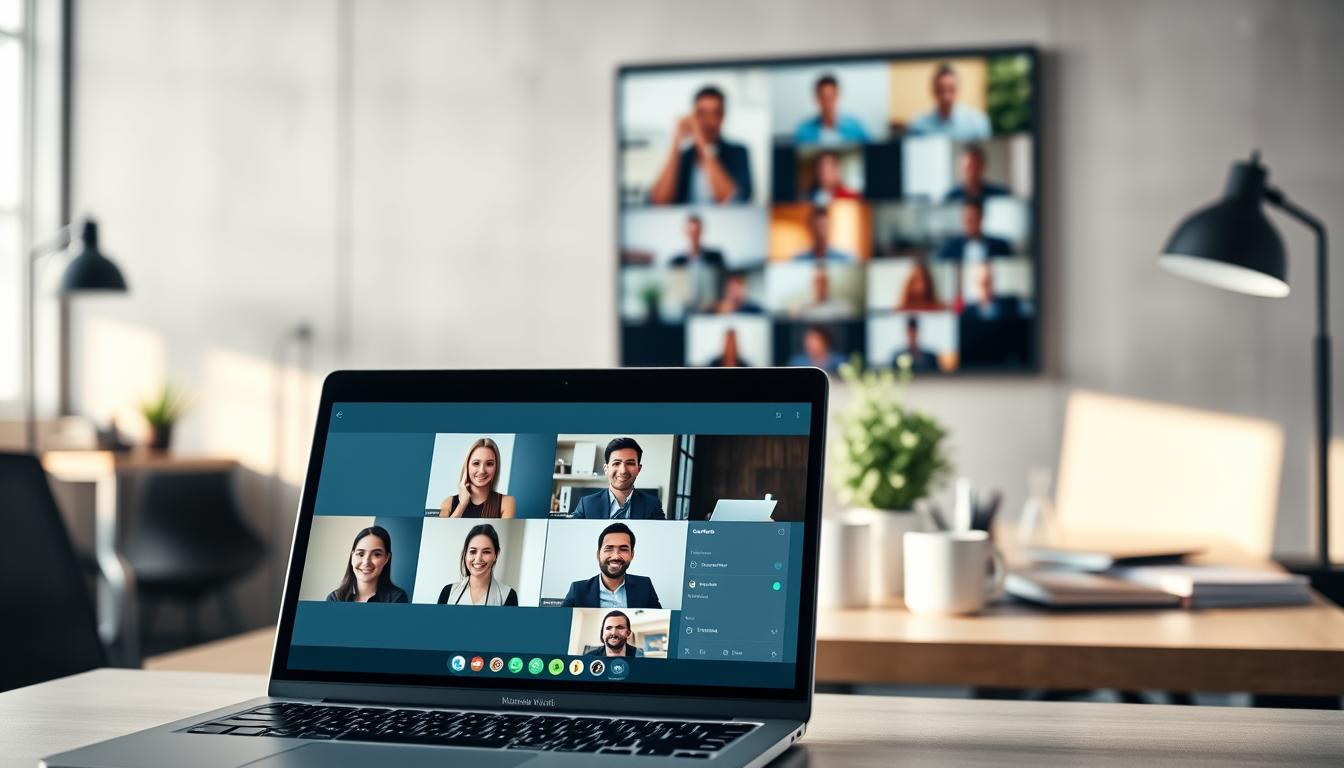In today’s swift work world, knowing how to conduct productive meetings is key. This guide will change old meeting habits into fruitful talks that have real results. With a focus on smart planning and doing, we’ll boost your team’s meeting skills. So, meetings will truly meet their goals and bring out the best from everyone.
Why Effective Meetings Matter
Meetings play a key role in making teams work better together. They offer a chance for people to share ideas, make decisions, and get on the same page. But meetings that are not well-organized can make people feel frustrated and like they’re wasting their time.
Meetings are really important. Research shows that when meetings have a clear purpose, team morale goes up. This leads to better work. Good meetings make sure everyone understands each other and work goes smoothly, making the whole organization do better.
For example, the U.S. sees about 24 billion wasted hours each year due to unproductive meetings. Teams need to focus on communicating well and keeping meetings on track. This way, they can make the most of their time together, leading to more work done and happier people.
Identifying the Purpose of Your Meeting
Knowing why you’re meeting is key to good planning. Every meeting should have one clear goal that steers the conversation. If it’s hard to find this goal, you may not need a meeting. Sometimes, a brief email or phone call is enough.
Start by asking: what should we achieve? Think about the decisions that need making and the results you want. A focused agenda keeps everyone on track and makes the best use of time. Setting a clear purpose is the first step to a successful meeting.
How to Run Effective Meetings
Running effective meetings needs a plan that aims for good results. At the heart of this plan is setting clear goals. When everyone knows the goals, meetings are more likely to succeed. Making the goals clear helps everyone stay on track.
Setting Clear Objectives for Success
To create a space where success is possible, start by setting specific goals for the meeting. This makes sure every topic discussed helps reach those goals. Here are some steps to set clear goals:
- Identify the main goal of the meeting.
- Ensure all participants understand their roles in achieving this goal.
- Outline the expected outcomes and how they align with organizational priorities.
Utilizing the ‘5 Why’s’ Technique
The ‘5 Whys’ technique is great for getting to the heart of meeting objectives. By asking “why” repeatedly about an issue, teams can find the main cause of problems. This approach not only clears up what you want to achieve but also improves conversation. It leads to well-thought-out solutions that match the goals. Using the 5 Whys helps keep meetings focused on important points, helping them be successful.
Creating an Effective Meeting Agenda
A well-planned meeting agenda acts like a map for successful talks. It helps leaders outline clear goals. This makes sure everyone knows what’s happening. A carefully made agenda sets the stage for a meeting that uses time wisely.
Structuring Your Agenda for Clarity
An agenda must be easy to understand. It should have:
- Main goals of the meeting
- Topics to discuss
- Order of items by importance
This approach lets people get ready and helps the meeting flow well. A good structure keeps meetings focused on their main purposes.
Including Time Allotments for Each Topic
Add time limits for each part of the agenda to keep things moving. Time rules help by:
- Making sure we use time well
- Keeping discussions brief
- Covering all topics within the planned time
Following these time limits can keep the meeting lively and effective. This helps make better decisions faster.
Choosing the Right Participants and Encouraging Engagement
Choosing who comes to a meeting is key for good team engagement and results. It’s important to pick people who really influence the topic. This makes communication better and meetings more relevant.
Selecting Relevant Team Members
Think about who to invite by looking at:
- People impacted by the meeting’s decisions.
- Members with special knowledge about the topics discussed.
- Important figures who can offer insights or approvals.
Having these individuals in the meeting makes discussions richer and more effective.
Creating a Comfortable Environment for Participation
Crafting a welcoming space lets everyone share their ideas. To do this:
- Start with a positive atmosphere, inviting everyone’s thoughts.
- Rotate tasks in meetings to keep everyone interested.
- Use strategies like round-robin discussions to hear every voice.
These methods boost team engagement by making people feel appreciated and heard.
Staying on Topic to Enhance Productivity
To have effective meetings, it’s critical to stay on point. This method makes conversations run smoothly, boosts productivity, and ensures we meet our goals. A key player in this is the meeting facilitator.
With the right experience and skills, this person keeps the conversation flowing in the right direction. They help keep everyone focused, especially when the discussion starts to wander.
The Role of a Meeting Facilitator
A meeting facilitator is vital for reaching productive goals. They keep an eye on the conversation, ensuring everyone stays on topic. At the beginning, they set clear rules, creating a space where good discussions can happen without off-topic distractions.
Strategies for Keeping Discussions Focused
Using smart strategies helps keep meetings on track. Here are some tips:
- Start every meeting with clear ground rules to guide the talks.
- Use video messaging to note down side issues that come up for later.
- Give each agenda item its own time slot to keep things organized.
- Ask everyone to share thoughts that matter, keeping an eye on the clock.
With these methods, teams can have better meetings. They’ll be more together and hit their targets by staying focused in discussions.
Summarizing Action Items Effectively
Summing up action items at meeting’s end is key. It helps remind everyone what we decided and what they need to do. Summaries should list everyone’s tasks and when they’re due. That way, folks know their duties and work better together.
To sum up action items well, you can:
- Go over each topic discussed and note important points.
- Name the tasks and who’s doing what.
- Set clear deadlines and make sure everyone knows what’s expected.
- Quickly share the summary so everyone’s on the same page.
Doing a recap like this makes sure no one’s confused about their tasks. It keeps the team moving forward. With this method, groups work smarter and get things done on time.
Following Up Post-Meeting
Having a follow-up quickly after a meeting is vital. It locks in what was decided. Sharing notes within a day helps everyone remember their tasks and promises. This step clarifies things and makes sure all stay responsible for their parts.
The Importance of Timely Follow-Ups
Timely follow-ups make sure everyone stays on the same page. When notes are sent out fast, any questions can be quickly handled. This keeps productivity high and accountability strong.
Utilizing Tools for Recap and Accountability
Using certain tools can vastly better the follow-up steps. Project management software helps keep track of tasks, and screen recording software shows what was discussed. These tools aid in making accurate meeting summaries and in keeping everyone on target with their duties.
Best Practices for In-Person Meetings
For in-person meetings to work well, it’s vital to have a good setup and clear roles. By making a welcoming space and assigning duties, everyone can get involved. This helps reach the meeting’s goals.
Setting Up the Physical Environment
A well-thought-out space can boost focus and teamwork. Important elements include:
- Adequate Lighting: Ensure the room is well-lit to reduce fatigue.
- Seating Arrangements: Choose layouts that encourage interaction, such as round tables or a U-shaped formation.
- Comfort Amenities: Provide refreshments and comfortable seating to keep energy levels high.
Assigning Pre-Meeting Roles
Defining clear roles before the meeting starts adds structure and responsibility. Think about giving out these roles:
- Facilitator: Guides the discussion and keeps the meeting on track.
- Note-Taker: Records key points and action items for future reference.
- Timekeeper: Monitors the agenda to ensure all topics receive adequate attention.
Maximizing Virtual Meetings Efficiency
Virtual meetings bring both benefits and challenges to working together effectively. They become much better when we use technology to engage everyone. Using interactive tools is key to making people feel connected, helping everyone speak up and making things clearer.
Leveraging Technology to Stay Engaged
Here are some strategies to keep everyone involved in virtual meetings:
- Use interactive polling to find out what people think and feel on the spot.
- Employ screen sharing to clearly show your points and keep everyone on topic.
- Integrate breakout rooms for small group chats that help participants connect more.
Pre-Meeting Preparation with Video Tools
Getting ready before the meeting is key to success. It’s vital to use video tools to share important info ahead of time. Making short videos about what the meeting will cover helps people arrive ready with questions or ideas. This method boosts productivity by ensuring everyone’s on the same page, leading to better talks.
Utilizing Collaboration Tools to Enhance Meeting Effectiveness
In our quick work life, using collaboration tools can make meetings way better. Loom, Miro, and Fellow are some tools that help us communicate better and work together more. With these tools, team members stay engaged and make meetings worthwhile.
How Loom and Other Platforms Can Streamline Meetings
Loom lets people make fast video updates, cutting down the need for long meetings. It’s great for sharing ideas and updates without needing everyone together at once. Loom helps teams share knowledge, train, and catch up quickly.
Taking Advantage of Virtual Whiteboards
Virtual whiteboards like Miro boost brainstorming and collaborative visuals. They make discussions lively and let everyone pitch in instantly. With these boards, teams can visually tackle complex subjects. This helps in capturing everyone’s input and keeping meetings on track.
Evaluating Meeting Outcomes
Evaluating meetings well is key for any group wanting to succeed. Getting feedback from those who attended can shed light on different parts of the meeting, like how well it was organized and if the topics discussed were relevant. By seeking out what people think, groups can get better over time.
Gathering Feedback from Participants
Surveys and casual talks are great ways to hear from attendees. Here’s what to keep in mind:
- Ask questions that match up with what the meeting aimed to achieve.
- Encourage open and helpful responses to get valuable insights.
- Use both numbers and stories to get the full picture.
Adjusting Future Meetings Based on Insights
Looking at feedback carefully helps to make meetings better. Teams should:
- Go over feedback often to find common complaints or suggestions.
- Make tweaks based on what they learn to improve future meetings.
- Tell attendees about these changes to show you are listening and want to make things better.

Transforming Your Team’s Meeting Culture
Creating a positive meeting culture boosts your team’s effectiveness. When meetings are seen as valuable, not just another task, teams become more productive. Setting rules that value everyone’s time helps ensure participants are prepared and ready to share their thoughts.
To boost engaging meetings, try these steps:
- Establish clear agendas to guide discussions and keep meetings focused.
- Encourage input from all attendees, valuing diverse perspectives and ideas.
- Implement regular feedback loops to understand how meetings can be improved.
Building a culture that looks forward to effective meetings can lead to more innovation and teamwork. This change improves engagement, and makes everyone feel responsible and involved.
Conclusion
For meetings to work well, organizations should see them as more than routine. Knowing the meeting’s goal helps tailor ways to keep everyone involved. This makes sure goals are hit. Good planning, like making clear agendas and having the right people there, boosts teamwork.
Following up on things to do is key for keeping everyone accountable. Making these steps a part of your group’s way of doing things turns meetings into chances for real talk. When teams follow best practices and use helpful tools, the way meetings are seen and done changes for the better.
Meetings are truly a way to make your team do better. By using the ideas in this guide, meetings can lead to real success and bring people together to create and innovate. It’s time to change how you think about meetings and make them work for you.



